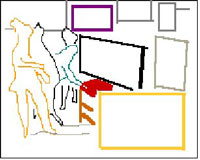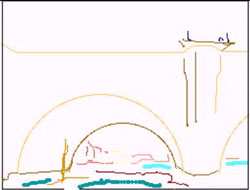| http://www.nationalgallery.org.uk
in search facility, type cognoscenti
Detail from Cognoscenti in a Room hung with Pictures (c.1620)

|
http://www.tate.org.uk/
in search facility, type Scott
Samuel Scott, An Arch of Westminster Bridge(c. 1750)

|
Paintings usually vary the spatial effect by articulating frames within frames, sometimes explicitly as in this view of a collectors paradise, which opens vistas in different directions:
- Multiples directions
- some of the frames are placed parallel to the picture plane (the
gold frame in the foreground, the greyish frames on the wall), creating
a miniature vista within the major one
- other frames are oblique, such as the black frame on the stool,
which is itself oblique; since it is placed behind the foreground
painting and in front of the paintings on the wall, it acts as an
intermediary between them
- Overlapping forms, which emphasise depth by showing some objects in
front of others
- the gold frame in the foreground partly covers the lower right-hand
corner of the black frame on the stool, but not that of the grey frame
on the right
- the figures overlap and also partly cover the pictures (the hats and
plumes interrupt the horizontal line of the grey frame to the left)
- Shadow
effects link the various motifs: the horizontal shadows
of the figures link up with the paintings placed on the
floor.
|
It is the opposite process: the frame within the frame is not a detail within the whole, on the contrary the major part of space is included in it.
- The cityscape is seen through it. It emphasises depth, since the
banks of the Thames from Westminster towards the City are twice
removed from the viewer, being beyond the bridge.
- Subjectively, it represents the viewers gaze framing the view, as
if looking through a telescope, and suggesting by its very
fragmentariness the breadth of the implicit view beyond it.
- the bridge acts as a second frame within the painting
- its curved shape suggests the round or oval frames which agree
with the cone of vision
|



